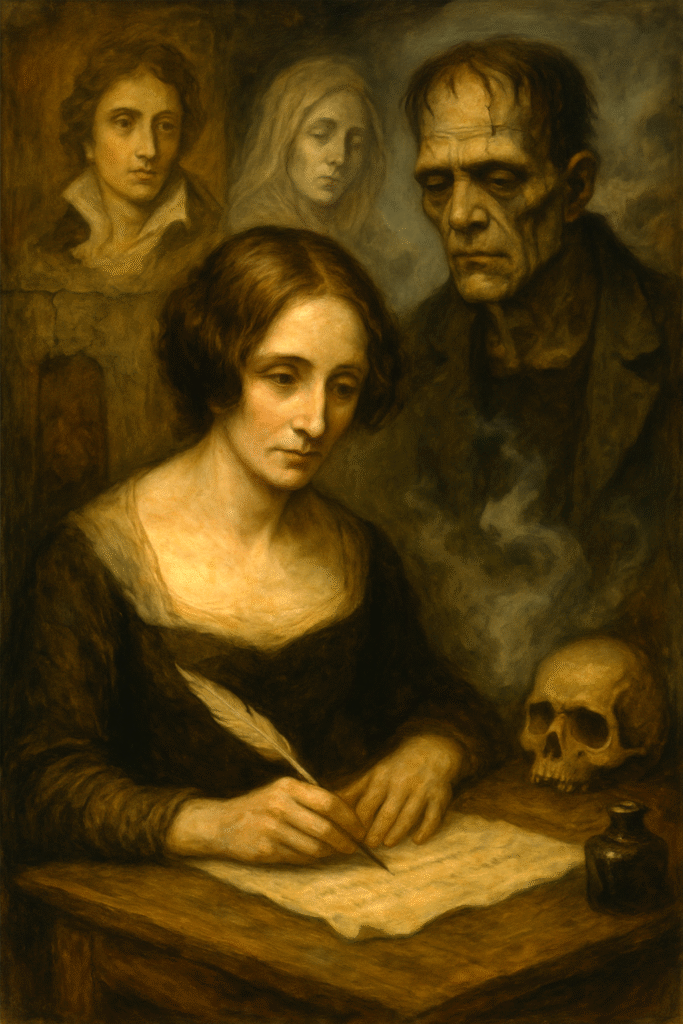Mary Shelley, born to prominent thinkers William Godwin and Mary Wollstonecraft, grew up in an environment steeped in intellectual thought and revolutionary ideas. From her early years, she faced immense personal tragedies that not only influenced her life but also deeply shaped her writing, most notably in her masterpiece, Frankenstein. This article will explore Mary Shelley’s real-life tragedies, their impact on her writing process, and the resultant themes of grief and creation in Frankenstein.
Introduction to Mary Shelley and Her Background
Born on August 30, 1797, Mary Wollstonecraft Godwin grew up in a household that valued education and progressive ideals. Her mother, Mary Wollstonecraft, was a feminist icon known for her work, A Vindication of the Rights of Woman, while her father, William Godwin, was a political philosopher. Mary’s early life was marked by significant loss; her mother died of complications shortly after her birth, a loss that profoundly affected her.
As a young woman, she eloped with the poet Percy Bysshe Shelley, an act that further isolated her from her family, especially after she became pregnant soon after their marriage. The tumultuous nature of their relationship, alongside financial and social struggles, formed the backdrop to her early literary endeavors. However, the ultimate tragedy that struck her was not merely one of social isolation or marital strife, but rather the heartbreak of losing several of her children, which would have devastating effects on her psyche and writing.
Analysis of Specific Tragedies That Influenced Her Life and Writing
The Loss of Her Mother
Mary’s mother, a pioneer of women’s rights, died just days after giving birth, leaving Mary with a profound sense of emptiness and loss. This early experience of losing a maternal figure instilled a complex relationship with motherhood, a theme that recurs in her novels. In Frankenstein, the creature suffers from a lack of familial connection, lamenting over its abandonment. This can be seen as a reflection of Shelley’s own yearning for maternal guidance and the consequent void in her life.
The Death of Her First Child
Mary gave birth to her first child, a daughter named Clara, in February 1815. Tragically, Clara died just a few weeks later, a catastrophe that shattered Mary’s emotional state. This experience of maternal grief would echo throughout her writing, particularly in Frankenstein. The themes of creation and destruction are vividly intertwined as Victor Frankenstein grapples with his responsibilities toward his creation, paralleling Mary’s own struggles with motherhood and loss.
The Passing of William Godwin
Another poignant moment in Mary Shelley’s life was the death of her father, William Godwin, in 1836. This event left her with a sense of disillusionment and profound sadness, encapsulated by her worsening financial instability. Godwin’s death marked the end of an era for Mary, further feeding into the themes of abandonment and sorrow in her works.
The Loss of Percy Shelley
Perhaps the most impactful tragedy was the death of her husband, Percy Bysshe Shelley, who drowned in 1822. This loss was devastating for Mary; she had not only lost her husband but also her closest confidant and intellectual partner. The emotional toll from this event led her to explore the darker sides of existence, the fears of loss, and the desire for immortality. In Frankenstein, Victor’s desperation to create life can be perceived as a reaction to his fear of death and loss, a maternal instinct brought about by Mary’s own experiences of tragedy.
Examination of Themes of Grief and Creation in ‘Frankenstein’
Grief as a Central Theme
Frankenstein is often seen as a narrative interwoven with the heavy themes of grief and isolation. Victor Frankenstein’s obsessive quest to overcome death by creating life is paradoxically fueled by his fear of losing the ones he loves. The creature, abandoned by its creator, suffers deeply as it craves acceptance and understanding, reflecting Shelley’s own feelings of alienation after the death of her loved ones.
The thematic use of grief extends beyond individual loss and taps into societal notions of how grief influences creative expression. Mary herself channeled her pain and sorrow into the pages of her novel, exposing her readers to the raw, emotional turbulence of bereavement. The ramification of grief in Frankenstein serves as a potent reminder of the consequences of isolation and the human condition—a testament to Shelley’s own life experiences.
Creation as a Response to Loss
Shelley’s concept of creation is also heavily influenced by her personal tragedies. In Frankenstein, Victor’s act of creating life can be interpreted as a desperate escape from the grief associated with his losses. Yet, this act of creation results in unintended consequences, paralleling Mary’s own experiences with motherhood, illustrating how the pursuit of life can lead to profound sorrow and alienation.
The creature, sprung from Victor’s scientific ambition and devoid of love or companionship, reflects Mary’s internal conflict with nurturing and loss. It questions the ethical implications of creation absent of responsibility, serving as a stark warning against unchecked ambition—a sentiment that can be traced back to Mary’s own life choices.
Historical and Cultural Context of the Time
The early 19th century, during which Shelley wrote Frankenstein, was a period marked by profound social and scientific upheaval. Industrialization was reshaping societies, challenging traditional views on nature and creation. Scientific advancements raised ethical questions about man’s role in creation, particularly through the lens of Enlightenment thought that celebrated human rationality and autonomy.
Moreover, the Romantic Movement, which celebrated emotion and the sublime aspects of nature, shaped Mary’s narrative style, creating a tension between intellectual understanding and emotional depth. The ghosts of the past—her personal losses—can be seen reflected against the backdrop of a society grappling with changes that questioned humanity’s relationship with nature and divinity.
As societal norms shifted, the exploration of individualism and emotion found their voice in literature. Mary Shelley’s Frankenstein emerged not only as an exploration of personal anguish but also as a critique of societal norms, illustrating her own life within the intercultural fabric of Early Romantic literature.
Conclusion
Mary Shelley’s Frankenstein offers an intricate tapestry woven from her narratives of loss and creation. By examining her real-life tragedies—the loss of her mother, her children, and Percy Shelley—it becomes evident how deeply her experiences of grief shaped her writing. These losses posed fundamental questions regarding life, death, and the ethical implications of creation.
The novel not only reflects Shelley’s personal struggles with grief and loss but also serves as a commentary on the broader themes of responsibility within the act of creation amidst a rapidly changing society. Mary Shelley’s life and literary contributions invite readers to reflect on the profound connections between personal experiences and the creative process, highlighting how tragedy can serve as both a burden and a catalyst for artistic expression.
FAQ Section
Q: What inspired Mary Shelley to write Frankenstein?
A: Mary Shelley was inspired by her life experiences, particularly personal tragedies involving loss and grief. Her relationship with Percy Shelley and the loss of her children significantly influenced the emotional depths of Frankenstein.
Q: How does Frankenstein address themes of grief?
A: Grief in Frankenstein is expressed through Victor Frankenstein’s anguish over his losses and the creature’s profound sense of abandonment. The novel explores how grief affects human relationships and creative endeavors.
Q: What societal changes influenced Mary Shelley’s writing?
A: The Romantic Movement and the early impacts of the Industrial Revolution influenced Shelley’s writing by emphasizing emotion and the individual’s relationship with nature and creation. These themes play a crucial role in the narrative of Frankenstein.
Q: How do Shelley’s tragedies compare with the themes in Frankenstein?
A: The personal tragedies faced by Mary Shelley, such as the loss of her mother and children, mirror the themes in Frankenstein, particularly regarding creation, loss, and the need for responsibility in the act of bringing life into being.
Q: What legacy did Mary Shelley leave behind through Frankenstein?
A: Mary Shelley’s Frankenstein established a foundation for Gothic literature and science fiction, laying bare the ethical dilemmas related to creation, in addition to giving voice to the struggles of human isolation and sorrow.


